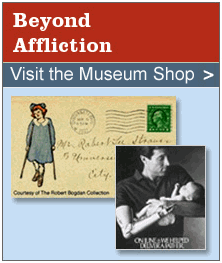Education: Lesson Details
Study Guide: Activities and Procedures
Section 1 - CLASS READING AND DISCUSSION
Background Essay: Religion In Nineteenth-Century America
After reading the background essay on religion in nineteenth-century America, discuss how changes in religious belief and practice may have energized efforts to expand access to education among people with sensory disabilities.
Section 2 - READING AND REACTION
Read the following background essays and then write a paragraph summarizing in your own words the main points made in each.
Background Essay: Asylum for the Deaf and Dumb
Background Essay: Monsieur Laurent Clerc
Background Essay: Samuel Gridley Howe, Romantic Reformer
Section 3 - READING
Read all the primary sources included in the lesson. While reading, think about what motivated each of the authors as they participated in the establishment of educational institutions for deaf and blind Americans. Find quotations that provide evidence of individual motivations. How do they connect with themes found in the background essays? Note that the sources are arranged in chronological order. Were the motivations consistent over time, or did motivations seem to change?
Section 4 - GROUP DISCUSSION
In groups, individual students report their general impressions of what motivated the individuals included in the packet of primary sources. They then analyze each of the primary documents, using the questions provided to guide their discussion.
Annotated & Abridged Document:
Mason Cogswell To John Braidwood, April 20, 1812
1.) Why did Mason Cogswell contact John Braidwood? What was the key factor in this first attempt to establish a deaf school in the United States?
2.) What words did Cogswell use to describe the condition of being deaf? Why?
Annotated & Abridged Document:
Report Of The Committee Of The Connecticut Asylum For The Education And Instruction Of Deaf And Dumb Persons
1.) How did religious aspirations shape this document? What seemed to be the primary motivation for educating the deaf?
2.) How was Thomas Gallaudet's investigation in Europe financed?
3.) What role did government play in the establishment of the Connecticut Asylum? Does this seem to violate the separation of church and state?
Annotated & Abridged Document:
Sermon, On The Duties And Advantages Of Affording Instruction To The Deaf And Dumb
1.) To whom did Gallaudet compare the deaf? In what kind of work did Gaulladet consider himself engaged?
Annotated & Abridged Document:
Eighth Report Of The Directors Of The American Asylum, At Hartford, For The Education And Instruction Of The Deaf And Dumb, Exhibited To The Asylum, May 15, 1824
1.) In what ways have the goals of deaf education shifted here? What might account for the change?
2.) Why might employment have been difficult to find for deaf people?
Annotated & Abridged Document:
Annual Report Of The Trustees Of The New-England Institution For The Education Of The Blind, 1833
1.) How was the establishment of the New England Asylum for the Blind similar to the establishment of the Connecticut Asylum for the Deaf? How was it different?
2.) What did Samuel Gridely Howe want from the government of Massachusetts? Upon what did he make his appeal?
3.) Why might blindness have been associated with poverty?
Annotated & Abridged Document:
Education Of The Blind
1.) How did Howe appeal for assistance in educating the blind in this passage from The North American Review?
Annotated & Abridged Document:
Annual Report Of The Trustees Of The New-England Institution For The Education Of The Blind, 1834
1.) What were the physical conditions of the New-England Institution For The Education Of The Blind, as described by Samuel Gridley Howe? How has it grown?
2.) How was the institution funded?
3.) What religious motivations did Howe suggest favor support for the New-England Institution For The Education Of The Blind? Why might be have been less explicit about religion than was Gallaudet?
Annotated & Abridged Document:
Twentieth Annual Report Of The Trustees Of The Perkins Institution And Massachusetts Asylum For The Blind
1.) Why might Howe have included questions about family history in this application for financial assistance for children attending the Perkins Institution?
Annotated & Abridged Document:
Acts And Resolves Relating To The Institution For The Blind
1.) How did the role of government in blind education change over time?
2.) Did the education of people with sensory disabilities shift from a religious issue to a political and economic one? If so, why?
Section 5 - CLASS DISCUSSION
Bring the entire class together to summarize their findings. What generalizations can be made about the founding of schools for people with sensory disabilities before the Civil War? What is the historical significance of their establishment? How were the schools connected with larger trends in American history? Why were these institutions founded when they were? Try to connect this topic with other topics you have covered or will cover in your class.
Bibliography
Lane, Harlan, When the Mind Hears: A History of the Deaf (New York: Random House, 1984).
Koestler, Frances A., The Unseen Minority: A Social History of Blindness in America (New York: D. McKay Co., 1976).
Van Cleve, John Vickrey, and Barry Crouch, A Place of Their Own: Creating the Deaf Community in America (Washington, D.C.: Gallaudet University Press, 1989).






